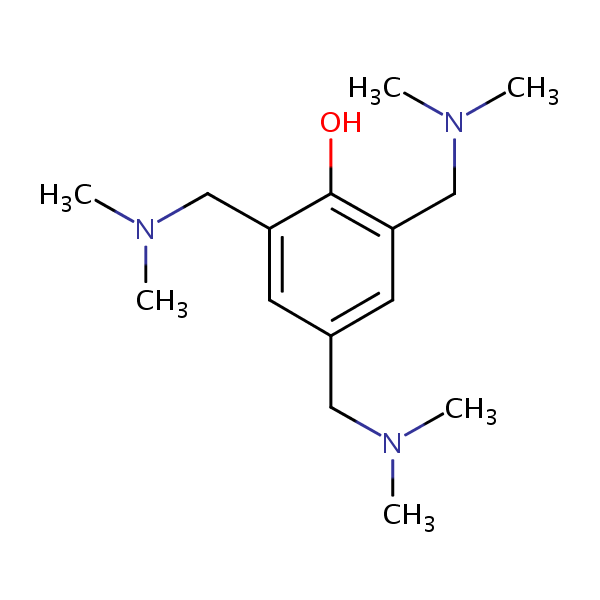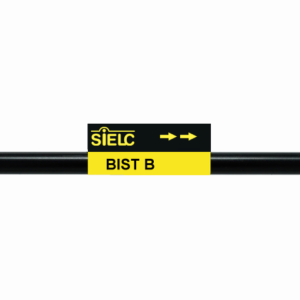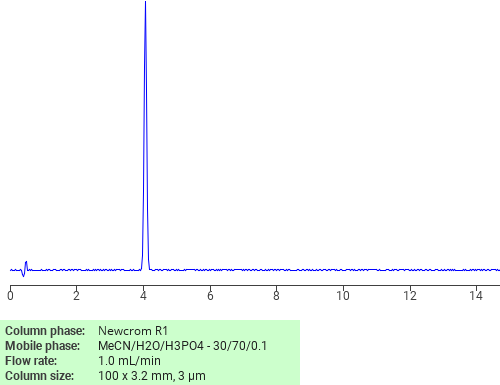| CAS Number | 90-72-2 |
|---|---|
| Molecular Formula | C15H27N3O |
| Molecular Weight | 265.402 |
| InChI Key | AHDSRXYHVZECER-UHFFFAOYSA-N |
| LogP | 1.16 |
| Synonyms |
|
Applications:
HPLC Method for Separation of Amines on BIST B and BIST B+ Columns
March 23, 2023
HPLC Method for Separation of Amines on BIST B and BIST B+ Columns by SIELC Technologies
Separation type: Bridge Ion Separation Technology, or BIST™ by SIELC Technologies
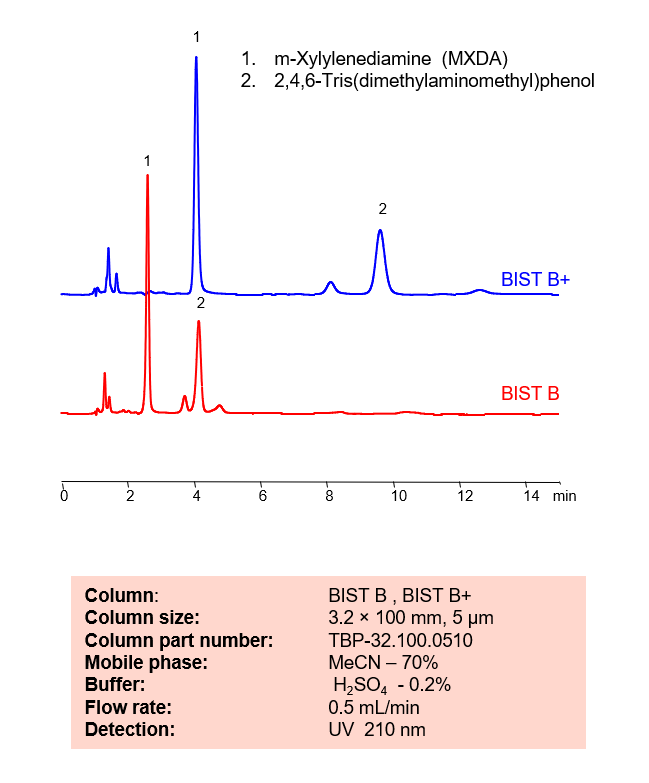
m-Xylylenediamine (MXDA) is a popular curing agent used on epoxy resins. 2,4,6-Tris(dimethylaminomethyl)phenol is another amine-based curing agent used on epoxy resins. Using SIELC’s newly introduced BIST™ method, these amines can be retained and separated on a positively charged, anion-exchange BIST™ B or BIST™ B+ column. The surface chemistry of BIST™ B+ columns are designed to have stronger ionic retention capabilities, resulting in the marked increase in retention compared to BIST™ B columns.
There are two keys to this retention method: 1) a multi-charged, negative buffer, such as Sulfuric acid (H2SO4), which acts as a bridge, linking the positively charged dipeptide to the positively charged column surface and 2) a mobile phase consisting mostly of organic solvent (such as MeCN) to minimize the formation of a solvation layer around the charged analytes. Using this new and unique analysis method, these two amines can be UV detected at 210 nm.
High Performance Liquid Chromatography (HPLC) Method for Analysis of Amines
Condition
| Column | BIST B, 3.2 x 100 mm, 5 µm, 100 A, dual ended |
| Mobile Phase | MeCN – 70% |
| Buffer | H2SO4 – 0.2% |
| Flow Rate | 0.5 ml/min |
| Detection | UV 210 nm |
| Peak Retention Time |
Description
| Class of Compounds | Amines |
| Analyzing Compounds | m-Xylylenediamine, 2,4,6-Tris(dimethylaminomethyl)phenol |
Application Column
BIST B
Column Diameter: 3.2 mm
Column Length: 100 mm
Particle Size: 5 µm
Pore Size: 100 A
Column options: dual ended
BIST B+
Column Diameter: 3.2 mm
Column Length: 100 mm
Particle Size: 5 µm
Pore Size: 100 A
Column options: dual ended
m-Xylylenediamine

HPLC Method for Separation of Amines in Non Aqueous MP on BIST B+ Column
March 1, 2023
HPLC Method for Separation of of Amines in Non Aqueous MP on BIST B+ by SIELC Technologies
Separation type: Bridge Ion Separation Technology, or BIST™ by SIELC Technologies
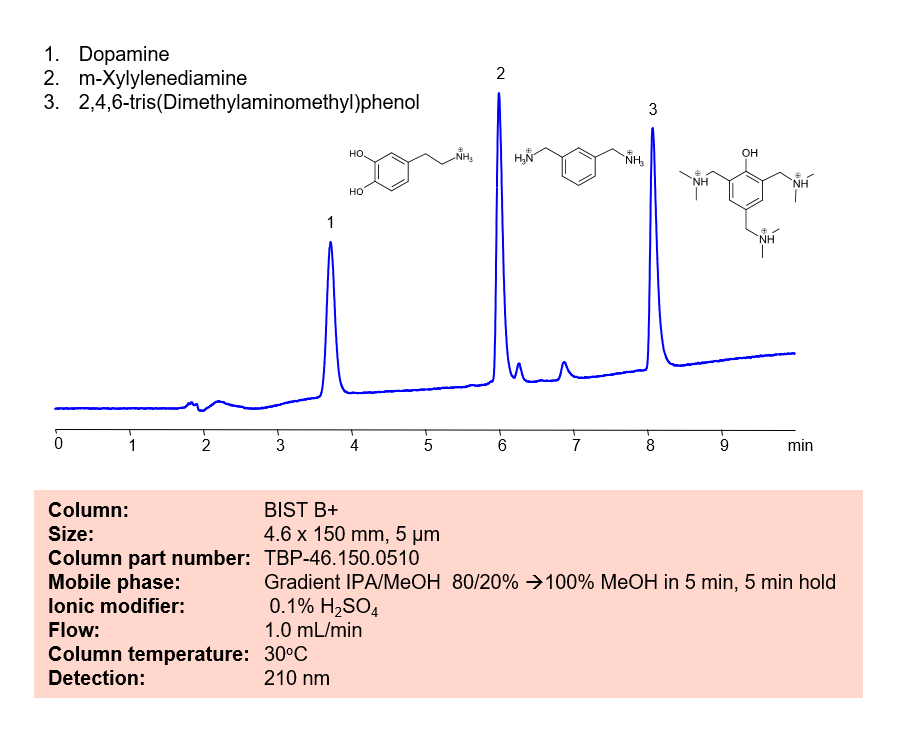
Dopamine is a key neurotransmitter and medical stimulant used to treat low blood pressure, low heart rate, and heart attacks. m-Xylylenediamine (MXDA) is a popular curing agent used on epoxy resins. 2,4,6-Tris(dimethylaminomethyl)phenol is another amine-based curing agent used on epoxy resins. Using SIELC’s newly introduced BIST method, these 3 amines can be retained on a positively-charged anion-exchange BIST B+ column. There are two keys to this retention method: 1) a multi-charged, negative buffer, such as Sulfuric acid (H2SO4), which acts as a bridge, linking the positively-charged analytes to the positively-charged column surface and 2) a mobile phase consisting mostly of less polar organic solvent (such as IPA) to minimize the formation of a solvation layer around the charged analytes. This method uses an entirely non-aqueous mobile phase to drive BIST retention. The gradient starts with a high concentration of the less polar IPA to generate the initial BIST retention and progresses to the more polar MeOH to elute the longer-retaining amines in a reasonable time. Using this new and unique analysis method, these 3 amines can be retained and UV detected at 210 nm.
High Performance Liquid Chromatography (HPLC) Method for Analysis of of Amines in Non Aqueous MP
Condition
| Column | BIST B+, 4.6 x 150 mm, 5 µm, 100 A, dual ended |
| Mobile Phase | Gradient IPA/MeOH- 80/20% to 100% MeOH, 5 min , 5 min hold |
| Buffer | H2SO4 – 0.2% |
| Flow Rate | 1.0 ml/min |
| Detection | UV 210 nm |
| Peak Retention Time | 3.52 min, 6.12 min, 8.57 min |
Description
| Class of Compounds | Amines |
| Analyzing Compounds | Dopamine, m-Xylylenediamine, 2,4,6-Tris(dimethylaminomethyl)phenol |
Application Column
BIST B+
Column Diameter: 4.6 mm
Column Length: 150 mm
Particle Size: 5 µm
Pore Size: 100 A
Column options: dual ended
Dopamine
m-Xylylenediamine

Separation of 2,4,6-Tris(dimethylaminomethyl)phenol on Newcrom R1 HPLC column
February 16, 2018
2,4,6-Tris(dimethylaminomethyl)phenol can be analyzed by this reverse phase (RP) HPLC method with simple conditions. The mobile phase contains an acetonitrile (MeCN), water, and phosphoric acid. For Mass-Spec (MS) compatible applications the phosphoric acid needs to be replaced with formic acid. Smaller 3 µm particles columns available for fast UPLC applications. This liquid chromatography method is scalable and can be used for isolation impurities in preparative separation. It also suitable for pharmacokinetics.
Application Column
Newcrom R1
The Newcrom columns are a family of reverse-phase-based columns. Newcrom A, AH, B, and BH are all mixed-mode columns with either positive or negative ion-pairing groups attached to either short (25 Å) or long (100 Å) ligand chains. Newcrom R1 is a special reverse-phase column with low silanol activity.
Select options